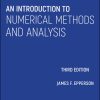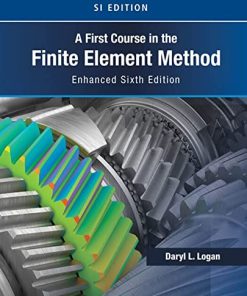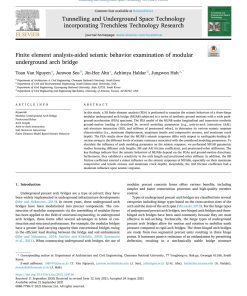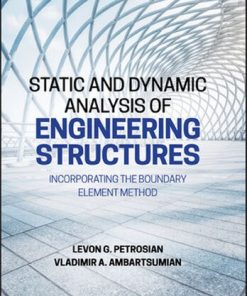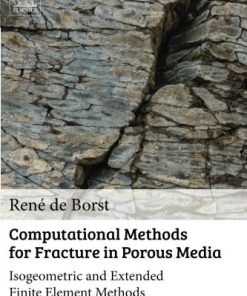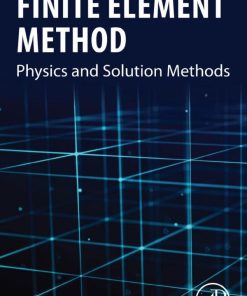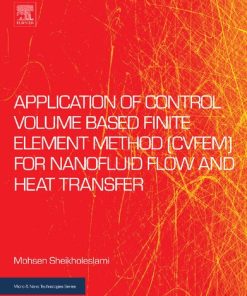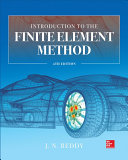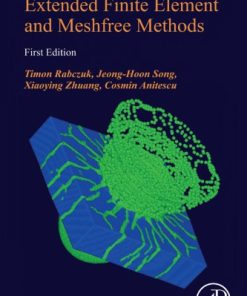Partition of Unity Methods The Extended Finite Element Method 1st edition by Stéphane Bordas, Alexander Menk, Sundararajan Natarajan 111853588X 9781118535882
$50.00 Original price was: $50.00.$25.00Current price is: $25.00.
Partition of Unity Methods: The Extended Finite Element Method 1st edition by Stéphane P. A. Bordas, Alexander Menk, Sundararajan Natarajan – Ebook PDF Instant Download/DeliveryISBN: 111853588X 9781118535882
Full download Partition of Unity Methods: The Extended Finite Element Method 1st edition after payment.
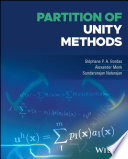
Product details:
ISBN-10 : 111853588X
ISBN-13 : 9781118535882
Author : Stéphane P. A. Bordas, Alexander Menk, Sundararajan Natarajan
While it is the number one tool for computer aided design and engineering, the finite element method (FEM) has difficulties with discontinuities, singularities, and moving boundaries. Partition of unity methods addresses these challenges and is now increasingly implemented in commercially available software. Partition of Unity Methods delivers a detailed overview of its fundamentals, in particular the extended finite element method for applications in solving moving boundary problems. The distinguished academics and authors introduce the XFEM as a natural extension of the traditional finite element method (FEM), through straightforward one-dimensional examples which form the basis for the subsequent introduction of higher dimensional problems. This book allows readers to fully understand and utilize XFEM just as it becomes ever more crucial to industry practice.
Partition of Unity Methods: The Extended Finite Element Method 1st Table of contents:
1 Introduction
1.1 The Finite Element Method
1.2 Suitability of the Finite Element Method
1.3 Some Limitations of the FEM
1.4 The Idea of Enrichment
1.5 Conclusions
References
2 A Step-by-Step Introduction to Enrichment
2.1 History of Enrichment for Singularities and Localized Gradients
2.1.1 Enrichment by the “Method of Supplementary Singular Functions”
2.1.2 Finite Element with a Singularity
2.1.3 Partition of Unity Enrichment
2.1.4 Mesh Overlay Methods
2.1.5 Enrichment for Strong Discontinuities
2.2 Weak Discontinuities for One-dimensional Problems
2.2.1 Conventional Finite Element Solution
2.2.2 eXtended Finite Element Solution
2.2.3 eXtended Finite Element Solution with Nodal Subtraction/Shifting
2.2.4 Solution
2.3 Strong Discontinuities for One-dimensional Problem
2.4 Conclusions
References
3 Partition of Unity Revisited
3.1 Completeness, Consistency, and Reproducing Conditions
3.2 Partition of Unity
3.3 Enrichment
3.3.1 Description of Geometry of Enrichment Features
3.3.2 Choice of Enrichment Functions
3.3.3 Imposition of boundary conditions
3.3.4 Numerical Integration of theWeak Form
3.4 Numerical Examples
3.4.1 One-Dimensional Multiple Interface
3.4.2 Two-Dimensional Circular Inhomogeneity
3.4.3 Infinite Plate with a Center Crack Under Tension
3.5 Conclusions
References
4 Advanced Topics
4.1 Size of the Enrichment Zone
4.2 Numerical Integration
4.2.1 Polar Integration
4.2.2 Equivalent Polynomial Integration
4.2.3 Conformal Mapping
4.2.4 Strain Smoothing in XFEM
4.3 Blending Elements and Corrections
4.3.1 Blending Between Different Partitions of Unity
4.3.2 Interpolation Error in Blending Elements
4.3.3 Addressing Blending Phenomena
4.4 Preconditioning Techniques
4.4.1 The First Preconditioner Proposed for the XFEM
4.4.2 A domain Decomposition Preconditioner for the XFEM
References
5 Applications
5.1 Linear Elastic Fracture in Two Dimensions with XFEM
5.1.1 Inclined Crack in Tension
5.1.2 Example of a Crack Inclusion Interaction Problem
5.1.3 Effect of the Distance Between the Crack and the Inclusion
5.2 Numerical Enrichment for Anisotropic Linear Elastic Fracture Mechanics
5.3 Creep and Crack Growth in Polycrystals
5.4 Fatigue Crack Growth Simulations
5.5 Rectangular Plate with an Inclined Crack Subjected to Thermo-Mechanical Loading
References
6 Recovery-Based Error Estimation and Bounding in XFEM
6.1 Introduction
6.2 Error Estimation in the Energy Norm. The ZZ Error Estimator
6.2.1 The SPR Technique
6.2.2 The MLS Approach
6.3 Recovery-based Error Estimation in XFEM
6.3.1 The SPR-CX Technique
6.3.2 The XMLS Technique
6.3.3 The MLS-CX Technique
6.3.4 On the Roles of Enhanced Recovery and Admissibility
6.4 Recovery Techniques in Error Bounding. Practical Error Bounds.
6.5 Error Estimation in Quantities of Interest
6.5.1 Recovery-based Estimates for the Error in Quantities of Interest
6.5.2 The Stress Intensity Factor as QoI: Error Estimation
References
7 ϕ-FEM: An Efficient Simulation Tool Using Simple Meshes for Problems in Structure Mechanics and Heat Transfer
7.1 Introduction
7.2 Linear Elasticity
7.2.1 Dirichlet Conditions
7.2.2 Mixed Boundary Conditions
7.3 Linear Elasticity with Multiple Materials
7.4 Linear Elasticity with Cracks
7.5 Heat Equation
7.6 Conclusions and Perspectives
References
8 eXtended Boundary Element Method (XBEM) for Fracture Mechanics and Wave Problems
8.1 Introduction
8.2 Conventional BEM Formulation
8.2.1 Elasticity
8.2.2 HelmholtzWave Problems
8.3 Shortcomings of the Conventional Formulations
8.4 Partition of Unity BEM Formulation
8.5 XBEM for Accurate Fracture Analysis
8.5.1 Williams Expansions
8.5.2 Local XBEM Enrichment at Crack Tips
8.5.3 Results
8.5.4 Auxiliary Equations and Direct Evaluation of Stress Intensity Factors
8.5.5 Fracture in Anisotropic Materials
8.5.6 Conclusions
8.6 XBEM for ShortWave Simulation
8.6.1 Background to the Development of PlaneWave Enrichment
8.6.2 PlaneWave Enrichment
8.6.3 Evaluation of Boundary Integrals
8.6.4 Collocation Strategy and Solution
8.6.5 Results
8.6.6 Choice of Basis Functions
8.6.7 Scattering from Sharp Corners
8.7 Conditioning and its Control
8.8 Conclusions
References
9 Combined Extended Finite Element and Level Set Method (XFE-LSM) for Free Boundary Problems
9.1 Motivation
9.2 The Level Set Method
9.2.1 The Level Set Representation of the Embedded Interface
9.2.2 The Basic Level Set Evolution Equation
9.2.3 Velocity Extension
9.2.4 Level Set Function Update
9.2.5 Coupling the Level Set Method with the XFEM
9.3 Biofilm Evolution
9.3.1 Biofilms
9.3.2 Biofilm Modeling
9.3.3 Two-Dimensional Model
9.3.4 Solution Strategy
9.3.5 Variational Form
9.3.6 Enrichment Functions
9.3.7 Interface Conditions
9.3.8 Interface Speed Function
9.3.9 Accuracy and Convergence
9.3.10 Numerical Results
9.4 Conclusion
Acknowledgment
References
10 XFEM for 3D Fracture Simulation
10.1 Introduction
10.2 Governing Equations
10.3 XFEM Enrichment Approximation
10.4 Vector Level Set
10.5 Computation of Stress Intensity Factor
10.5.1 Brittle Material
10.5.2 Ductile Material
10.6 Numerical Simulations
10.6.1 Computation of Fracture Parameters
10.6.2 Fatigue Crack Growth in Compact Tension Specimen
10.7 Summary
References
11 XFEM Modeling of Cracked Elastic-Plastic Solids
11.1 Introduction
11.2 Conventional von Mises Plasticity
11.2.1 Constitutive Model
11.2.2 Asymptotic Crack Tip Fields
11.2.3 XFEM Enrichment
11.2.4 Numerical Implementation
11.2.5 Representative Results
11.3 Strain Gradient Plasticity
11.3.1 Constitutive Model
11.3.2 Asymptotic Crack Tip Fields
11.3.3 XFEM Enrichment
11.3.4 Numerical Implementation
11.3.5 Representative Results
11.4 Conclusions
References
12 An Introduction to Multiscale analysis with XFEM
12.1 Introduction
12.1.1 Types of Multiscale Analysis
12.2 Molecular Statics
12.2.1 Atomistic Potentials
12.2.2 A simple 1D Harmonic Potential Example
12.2.3 The Lennard-Jones Potential
12.2.4 The Embedded Atom Method
12.3 Hierarchical Multiscale Models of Elastic Behavior – The Cauchy-Born Rule
12.4 Current Multiscale Analysis – The Bridging Domain Method
12.5 The eXtended Bridging Domain Method
12.5.1 Simulation of a Crack Using XFEM
People also search for Partition of Unity Methods: The Extended Finite Element Method 1st:
partitions of unity
partition allocation methods
partition of unity proof
partitioning a unit of something
an example of partitioning a unit of something
Tags:
Partition,Unity Methods,The Extended Finite,Element Method,Stéphane Bordas,Alexander Menk,Sundararajan Natarajan
You may also like…
Engineering - Mechanical Engineering & Dynamics
A First Course in the Finite Element Method 6 Enhanced SI Edition
Uncategorized
Engineering - Civil & Structural Engineering
The Inclusion-Based Boundary Element Method (iBEM)1st Edition Huiming Yin
Physics - Theoretical Physics
Finite Element Method: Physics and Solution Methods Sinan Muftu
Mathematics - Applied Mathematics
Extended finite element and meshfree methods 1st Edition Timon Rabczuk


